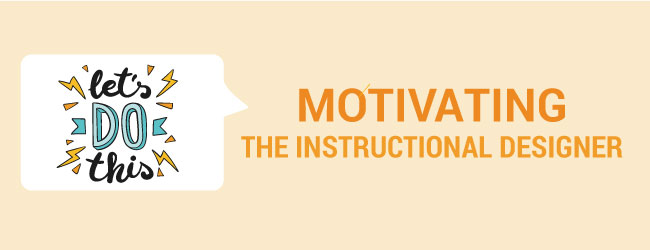
Perhaps it hits you when you’re writing a storyboard to teach a poorly designed software program. Or maybe you just received an eLearning review from a course sponsor and there are revisions on every slide. Suddenly your de-motivation button is triggered and you can’t seem to shake it off. You start to wonder why you’re doing this in the first place.
We spend a lot of time theorizing and thinking about how to motivate learners. But what about motivating instructional designers? We often sit at a computer for untold hours doing work that no one else understands, often wearing many hats, and sometimes working with dry or boring content. Yet I still love this field. So here’s my advice for ways to get and stay motivated when you’re less than excited about your work.
1. You’re the learner’s advocate
When I was studying Instructional Design, a college professor once told the class that we were the learners’ advocates. I’ve never forgotten those words. An advocate “pleads the cause of another; defends or maintains a cause or proposal; and supports or promotes the interests of another,” according to Webster online.
We’re the ones who take the learner seriously and ensure that things are explained clearly, that the experience is engaging, that tests are fair, and so on. Advocating for learners is a purposeful and motivating mission.
2. Remember that your course will help someone
Instructional Design is a selfless job because it’s not about you, it’s about them—the learners. Your course has the potential to help another person become more competent at work, life or school. This has a ripple effect.
I’ve created courses that taught people how to save lives, to cooperate as a team, to operate heavy equipment safely, and to use software. I’m sure you’ve created life changing learning experiences too or will some day. This is fulfilling work and that’s motivating.
3. Dive in heart and soul until it becomes interesting
Everything under the sun can be fascinating if you see it from the right perspective. Look at the content from both a bird’s eye view as well as from a detailed view. Let your mind expand as you immerse yourself in it and explore connections and relationships. It’s bound to become more intriguing as you work your way through the material with wonder and curiosity.
4. Imagine you’re the learner
Put yourself in the place of the learner to understand the value of the learning experience that’s in your hands to shape. Consider how the experience will relate to the learner’s universe. Imagine how you would like to encounter this information if you were the learner. Then psych yourself to find ways to make it compelling.
5. Think visually
Visual thinking prompts you to look at things in a unique way. Even when you’re not an artist, you can still sketch while thinking—with stick figures and geometric shapes. Sketching is a cognitive aid that might help you break through the doldrums.
Use mind maps to analyze and organize content and to plan out interactions. Draw charts and diagrams to understand relationships. Doodle. Check out The Back of the Napkin.
6. Get fascinated by the brain
Problem-solving is a motivating task. Your problem is how to provide an engaging learning experience that turns information into knowledge that gets transferred to real world situations. This takes understanding how the mind works and how people process information.
You might get inspired by reading about the workings of the brain and about how people learn. See How the Mind Works by Stephen Pinker. When you’re reminded of how astounding the human brain is, you may find it motivating to apply more learning theory and brain science to your work.
7. Look around at other works
Take some time to check out other eLearning courses around the web. You’ll find people are coming up with great ideas for interactions, treatments, visuals and instructional strategies. Finding new ideas might inspire you to try a few out yourself. Here’s a resource for finding online courses and demos.
If you get inspired by visual design, collect a few graphic design books and browse them when you’re feeling unmotivated, visit a bookstore or check out design blogs.
8. Create robust learning experiences
It’s motivating to think in terms of creating an experience rather than a solitary course. You can go beyond the generic single course concept by creating a variety of online and offline events that support learning. Consider alternative instructional strategies, like adding social media technologies and informal approaches.
When you try out new strategies, it not only motivates learners, it can potentially motivate you. Check out: 30 Ways to Motivate Adult Learners.
9. Seek out community
I’ve never experienced friendlier and more helpful communities than those built around learning specialists, instructional designers and developers. You’re not alone in this field and you can get support, inspiration and answers to issues through the many online communities of practice associated with online learning. Check out many of the groups on LinkedIn and Facebook as well as professional organizations like The Learning Guild and ATD. I also have a membership community for instructional designers who want to learn new skills: Mastering Instructional Design.
10. Analyze yourself
I don’t want to get all pop psychology on you, but let’s face it, sometimes when you’re unmotivated it’s not the work itself but the workplace. Consider whether something else is going on.
Perhaps you don’t feel valued at work, you’re underpaid or your deadlines are unreasonable. If this is the case, try to separate your issues about the workplace from the actual work you’re doing. Try to take care of the workplace situation or promise yourself you’ll take care of it soon. Then put it aside so you can get motivated to do a great job for the learners. They deserve it.
How do you stay motivated? Please comment below.

Sweet! Thanks for sharing a little of your story, Sadhana.
Connie
Hi Connie,
I love my job like you do and keep looking to make it more interesting and motivating for me and the others I work with. I have been doing most of the things that you have mentioned here. The one thing that I haven’t done lately is “Look around at other work”. Caught up by work and insufficient time, I have forgotten to do this.
Will definitely start doing it htough. Thanks for the remider!
Sadhana
Hi Christopher,
Thanks for the addition to this post! Would be good to see what other people can add.
Best,
Connie
I’m glad this helped. Maybe you should eventually work with a team of IDers, so you’re not the only one. As to getting ideas, please see my eLearning Demos list in the Resources section. There are many more examples around the Web too.
Thank’s I needed this. All the things you mention being the learner’s advocate, helping people learn, creating great learning experiences is why I love being an instructional designer.
But, yes it can be lonely – nobody understands what I’m doing and there are days when I just can’t get a great idea.
Again, thanks for reminding me what a great job I really have.
We, instructional designers really need motivation after having jostled on with numerous word and PowerPoint storyboards. As my first stint as an instructional designer, in the K-12 domain, I loved to try to think visually, Now i know that I’m on the right track. Thanks Connie for showing me the light with this wonderful article.
Thanks, Dass. Some day, we’ll rule the world, you know: If Instructional Designers Ran The World
Hi Connie! This a motivating article indeed! Being an Instructional Designer, I can work with an asserted pride! Thanks for sharing!
Dass
I like this article. Many times people forget that instructional design is really an art that takes information and organizes it into a logical format that greats an engaging learning experience. Check out this article: http://www.instructionaldesignexpert.com/Art-of-instructional-design.html
Hi Connie! This is a very inspiring article and i took the chance in translating it to portuguese to post at my company´s blog. Here´s the link http://penseelearning.gsionline.com.br/
We´re a eLearning startup from Brazil and love your blog, keep the articles coming!
Ps.: the post in portuguese give all the credit to your authorship.
Hi Evan. I guess we need all the inspiration we can get, so glad it worked for you.
Connie
This is a really helpful article that I found applicable to more than just instructional design. Quite inspiring. Thanks!
Hi Martonia, I’m glad you liked it. Thanks for stopping by.
Connie
This is a nice short article that summarizes what Instructional Design is all about. Thanks for sharing-
Glad you agree, Virtual! Thanks for stopping by.
Connie
Nice reminders! And all true 🙂